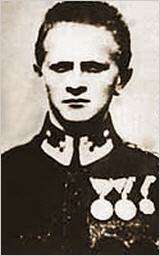Eugen Bönsch
| Eugen Bönsch | |
|---|---|
 | |
| Born |
1 May 1897 Velká Úpa, Austria-Hungary |
| Died |
24 July 1951 (aged 54) Ehrwald, Austria |
| Allegiance | Austro-Hungarian Empire; Germany |
| Service/ | Aviation |
| Rank | Feldwebel (later Hauptmann) |
| Unit | Flek 8, Flek 6, Flik 51J |
| Awards | 3 Gold Awards of the Medal for Bravery |
| Other work | Hauptmann (captain) in Luftwaffe during World War II |
Feldwebel Eugen Bönsch was a World War I flying ace credited with 16 aerial victories.[1]
Early life and service
Bönsch studied mechanics at the State Trade School. He originally joined the army in 1915, but after completing basic training transferred to aviation.[2] His original assignment was as a mechanic with Fliegerersatzkompagnie 6.[3]
Flying service
He requested flight training in 1917. He completed it at Flek 8 on 22 June 1917. His promotion to corporal followed six days later. In August, he was assigned to Flik 51 on the Italian front; he scored his first victory shortly thereafter, on 1 September,[4] teamed with Franz Wognar.[5] He became a balloon buster with his next triumph, on 28 September; it took several firing passes at 700 meters altitude through heavy ground fire, dodging a couple of enemy fighters, to down the balloon. In the next thirteen months, his victory skein would include five more balloons,[6] making him the Austro-Hungarian's leading balloon killer.[7] He received his first Medal for Bravery for this victory. He also downed a Nieuport the following day.[8][9]
Bönsch began the new year of 1918 by surviving being shot down by anti-aircraft fire.[10] He also added other dimensions to his flying repertoire. On 10 March, he led such a determined assault on an escorted of Italian Capronis that the bombers aborted the mission. The next day, Bönsch began a week of low-level raids on the Italian airfields at Marcon and Treviso, and the port of Portegrandi. The next few months, from April through October, Bönsch carried out a hectic double load of air-to-air combat intermixed with ground attack strikes, including at the Battle of the Piave.[11]
On 8 October 1918, he became one of the few World War I pilots to survive being set afire; he parachuted to safety.[12] He made his way back to his home airfield from enemy territory and returned to battle.[13] He scored his final four victories after this incident.[14] By 24 October, the Battle of Vittorio Veneto had worn the local Austro-Hungarian air force down to only 29 planes. Bönsch was one of the remaining pilots, and scored two victories on the 27th, and one each on the 28th and 29th.[15]
Post World War I
After the war, he was an innkeeper. When World War II began, he returned to duty and was appointed Hauptmann because of his prior experience.[16] He then served at Oschatz Air Base in Saxony.[17][18]
Sources of information
- ↑ http://www.theaerodrome.com/aces/austrhun/bonsch.php Retrieved 6 January 2010.
- ↑ http://www.theaerodrome.com/aces/austrhun/bonsch.php Retrieved 6 January 2010.
- ↑ Balloon Busting Aces of World War I. p. 78.
- ↑ http://www.theaerodrome.com/aces/austrhun/bonsch.php Retrieved 6 January 2010.
- ↑ Austro-Hungarian Aces of World War 1. pp. 67–68.
- ↑ http://www.theaerodrome.com/aces/austrhun/bonsch.php Retrieved 6 January 2010.
- ↑ http://www.theaerodrome.com/aces/balloon_busters.php?pageNum_score=3&totalRows_score=74 Retrieved 6 January 2010
- ↑ Balloon Busting Aces of World War I. p. 78.
- ↑ Austro-Hungarian Aces of World War 1. p. 69.
- ↑ Balloon Busting Aces of World War I. p. 78.
- ↑ Austro-Hungarian Aces of World War 1. p. 70.
- ↑ http://www.theaerodrome.com/aces/austrhun/bonsch.php Retrieved 6 January 2010.
- ↑ "Archived copy". Archived from the original on 2008-10-15. Retrieved 2008-10-30. Retrieved 6 January 2010.
- ↑ http://www.theaerodrome.com/aces/austrhun/bonsch.php Retrieved 6 January 2010.
- ↑ Austro-Hungarian Aces of World War 1. p. 71.
- ↑ "Archived copy". Archived from the original on 2008-10-15. Retrieved 2008-10-30. Retrieved 6 January 2010.
- ↑ http://www.theaerodrome.com/aces/austrhun/bonsch.php Retrieved 6 January 2010.
- ↑ Austro-Hungarian Aces of World War 1. p. 71.